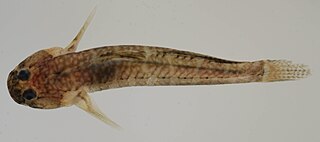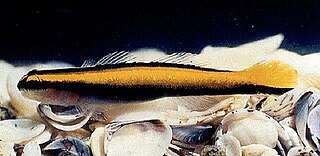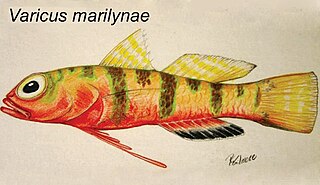
Gobiidae or gobies is a family of bony fish in the order Gobiiformes, one of the largest fish families comprising more than 2,000 species in more than 200 genera. Most of gobiid fish are relatively small, typically less than 10 cm (3.9 in) in length, and the family includes some of the smallest vertebrates in the world, such as Trimmatom nanus and Pandaka pygmaea, Trimmatom nanus are under 1 cm long when fully grown, then Pandaka pygmaea standard length are 9 mm (0.35 in), maximum known standard length are 11 mm (0.43 in). Some large gobies can reach over 30 cm (0.98 ft) in length, but that is exceptional. Generally, they are benthic or bottom-dwellers. Although few are important as food fish for humans, they are of great significance as prey species for other commercially important fish such as cod, haddock, sea bass and flatfish. Several gobiids are also of interest as aquarium fish, such as the dartfish of the genus Ptereleotris. Phylogenetic relationships of gobiids have been studied using molecular data.

The mountain whitefish is one of the most widely distributed salmonid fish of western North America. It is found from the Mackenzie River drainage in Northwest Territories, Canada through western Canada and the northwestern USA in the Pacific, Hudson Bay and upper Missouri River basins to the Truckee River drainage in Nevada and Sevier River drainage in Utah.

Holacanthus bermudensis, also known as the blue angelfish or Bermuda blue angelfish, is a species of ray-finned fish, a marine angelfish belonging to the family Pomacanthidae. It occurs in the western Atlantic Ocean.
Sicyopterus lagocephalus, the red-tailed goby or blue stream goby, is a species of goby native to islands of the Indian Ocean from the Comoros to the Mascarene Islands to the Pacific Ocean where it reaches French Polynesia and can be found as far north as Japan. It is an amphidromous species: adults can be found in swift-flowing streams with rocky beds but the eggs hatch at sea and the larval stage remains in marine waters, migrating to freshwaters when they reach the postlarval stage. This species can reach a total length of 13 cm (5 in). In some places it is an important species for local consumption with the post-larvae being caught as they mass in estuaries.

Elacatinus is a genus of small marine gobies, often known collectively as the neon gobies. Although only one species, E. oceanops, is technically the "neon goby," because of their similar appearance, other members of the genus are generally labeled neon gobies, as well. Except for a single East Pacific species, all reside in warmer parts of the West Atlantic, including the Caribbean and Gulf of Mexico. They are known for engaging in symbiosis with other marine creatures by providing them cleaning service that consists of getting rid of ectoparasites on their bodies. In return, Elacatinus species obtain their primary source of food, ectoparasites.

The common goby is a species of ray-finned fish native to fresh and brackish waters along the Atlantic and Baltic Sea coasts of Europe and northern Africa, with a range stretching from Norway to Morocco and Mauritania. It is also found in the Canary Islands. This species reaches a maximum length of 9 centimetres (3.5 in) TL.

The Gobiiformes are an order of fish that includes the gobies and their relatives. The order, which was previously considered a suborder of Perciformes, is made up of about 2,211 species that are divided between seven families. Phylogenetic relationships of the Gobiiformes have been elucidated using molecular data. Gobiiforms are primarily small species that live in marine water, but roughly 10% of these species inhabit fresh water. This order is composed chiefly of benthic or burrowing species; like many other benthic fishes, most gobiiforms do not have a gas bladder or any other means of controlling their buoyancy in water, so they must spend most of their time on or near the bottom. Gobiiformes means "goby-like".

Elacatinus puncticulatus is a species of goby from the eastern central Pacific Ocean, where it is found on reefs from the Gulf of California to Ecuador. This species occurs at depths ranging from 1 to 21m, and usually in association with the sea urchin Eucidaris thouarsii. The size of the goby varies depending on sex, with females being typically smaller than males, and their geographical location as well as their role as a cleaner goby also has impacts on their morphology. Due to their bright coloration and lack of aggression, the species is commonly found in the aquarium trade.

True gobies were a subfamily, the Gobiinae, of the goby family Gobiidae, although the 5th edition of the Fishes of the World does not subdivide the Gobiidae into subfamilies. They are found in all oceans and a few rivers and lakes, but most live in warm waters. Altogether, the Gobiinae unite about 1149 described species in 160 genera, and new ones are still being discovered in numbers.

Elacatinus evelynae, the sharknose goby, Caribbean cleaner goby, Caribbean cleaning goby, is a species of goby native to the Western Atlantic Ocean from the Bahamas and the Lesser Antilles to the northern coast of South America, as well as the Antilles and western Caribbean.
Elacatinus horsti, the yellowline goby, is a species of goby native to the western Atlantic Ocean and the Caribbean Sea.
Elacatinus chancei, the shortstripe goby, is a species of ray-finned fish in the family Gobiidae. It lives inside or on the surface of a sponge and occurs in tropical waters in the west central Atlantic Ocean, the Bahamas, the Antilles, and Venezuela.

Trachidermus fasciatus is a species of fish in the superfamily Cottoidea, the sculpins, and the only member of the monotypic genus Trachidermus. Its common name is roughskin sculpin. It has also been called four-gilled perch. It is native to the coastlines of China, Japan, and Korea, where it occurs at the mouths of rivers.
Paedogobius kimurai is a species of goby from the subfamily Gobionellinae, and the only member of the monotypic genus Paedogobius. It is native to marine and brackish waters of inner bays in Japan, Thailand and Australia. Its English language common names include wide-gape paedomorphic goby and babyface goby. Its Japanese language common name is shirasukiba-haze.

The frillfin goby is a species of marine fish in the genus Bathygobius.

The seaboard goby is a species of fish belonging to the family Gobiidae.

Elacatinus figaro, the barber goby or yellow line goby, is a colourful species of marine goby, family Gobiidae, from the southwestern Atlantic, where it is endemic to the coastal waters of Brazil.

The orangebelly goby is a species of fish described by Gilmore in 1979. It is known only from a pair of specimens collected from the eastern and western sides of the Florida Peninsula.

Pleurosicya mossambica, also known as the toothy goby or the Mozambique ghost goby, is a small species of goby native to the tropical Indo-West Pacific region. It was first described by South African ichthyologist J.L.B. Smith in 1959. Like many other gobies, it forms commensal relationships with several other marine invertebrates, including soft corals and sponges.
Evermannichthys bicolor is a perciform species of fish in the family Gobiidae. As their name suggests, fishes in this species live inside sponges and can be found in the Caribbean Sea. The size of their populations are unknown, meaning it is not currently clear whether the bicolored sponge goby is in need of conservation.














